
MAY CONTAIN NUTS

Search Shorpy
SHORPY ART

Framed or unframed, desk size to sofa size, printed by us in Arizona and Alabama since 2007. Explore now.
Join and Share
Ad-Free Shorpy
Shorpy is funded by you. Patreon contributors get an ad-free experience.
Learn more.

Recent comments
- Pinstripes in the Tower
- Sound enhancement
- 3438 in '38
- Second Career
- Their days are numbered
- Only the Sensor
- Train control mechanism
- Rarest of the Rare?? & Classy 3400 Class
- Control Mechanism
- Those standpipes
- Wrenches
- International D-40 I believe
- Job prospects
- You had me at Train
- Land of the free
- Broad-Exchange Bldg
- Parking innovation
- The old block
- "Peck turned a sweet propeller"
- National Bank Building
- Notch shot
- Straight ahead (right, left, left, right)
- Ship lifespans
- New service
- You Say Station, I Say Potato ...
- Iron Age
- Thank you, Cornelius Vanderbilt
- Grand Central Terminal
- If they made a movie of it
- Obsolete by then.
Member Photos
The Shorpy
Printporium
Printporium
Search Shorpy
Search results -- 30 results per page
- Hungry Jacks: 1937
- September 1937. "Lumberjacks at dinner. Camp near Effie, Minnesota." Nitrate negative by ... Posted by Dave - 03/05/2010 - 10:12am -
![Hungry Jacks: 1937 September 1937. "Lumberjacks at dinner. Camp near Effie, Minnesota." Nitrate negative by Russell Lee for the Resettlement Administration. View full size.
OdoriferousI'm trying to imagine what that dining hall smelled like.
The age thingYou kind of expect lumberjacks to be young. Most, if not all, of these seem to be middle age or more
I wonder ...... if I can make a grab for them cookies?
The Food They AteHere is my all-time favorite forestry article from my years working for the Forest Service (though it isn't one of theirs). It is utterly fascinating, especially one of the statements that a working logger could eat 9000 calories a day.
Good 'n PlentyThe food had to be good, filling, and plenty of it, though there were some camps where the food was terrible. A logger needed double the number of calories of a regular worker to carry them through a day of hard labour in the middle of winter.
There's a great book called... (wait for it!) "The Lumberjacks" about life in the lumber camps which has a chapter on the cookhouse.
Fried pork was such a popular part of the men's diet that in 1857 when the camp bosses decided that the pork should be boiled and not fried (boiling meant that the pork went further so was cheaper) the men put up such a stink that they had to back down.
Coffee didn't appear in the in the camps until Norwegian lumberjacks started demanding it.
Dig InDoesn't look like much dinner-table conversation going on. In that neck of the woods, so to speak, dinner refers to the noon meal, so they might be too hungry and pressed for time to gossip much.
My grandfather was a lumber-camp cook in Upper Michigan back at the turn of the century. He said heaven help you if the men didn't care for your cuisine.
Soap, Scrub, Rinse and Towel DryAnd imagine the mountains of dishes, bowls, glasses, cups and cutlery that had to be washed and dried!
[No need to imagine -- we saw them a few days ago. - Dave]
Probably not the Emo Vegetarian campI don't see any wildflowers being pressed.
Muti-useWhat immediately strikes me about this photo is that there is not a plastic fork, paper plate, disposable napkin, or disposable tin casserole dish in sight! Today at least some of those throwaway items would definitely be a part of the scene.
Not that I'd want to wash all those dishes, but ...
And there's pie too.What a great picture! Imagine the amount of work it took to feed these guys.
Not your mother's best china!Long tables and benches and all those porcelain covered steel dishes, bowls and cups (most of them chipped) reminds me of summer camp 30 years ago!
ChowhoundsNo chitchat here. Eating is all business for these guys, and the food better be good, especially after a full, hard day at the mill or in the forest. Now drinking -- maybe that's another story!
Mr. MannersNot a single hat is being worn at the table - and there are no elbows resting on the table as well. Heck, I don't even see anyone talking with their mouth full!
Still, they probably all curse like, uh, lumberjacks.
Samoa CookhouseIf any of y'all ever visit the northern California coast, there's a lumber camp cookhouse kept open for tourists. It's located in Samoa, near Eureka. All-you-can-eat rib-sticking food.
It's been ten years since I visited, but I do remember enjoying it.
(The Gallery, Mining, Russell Lee)](https://www.shorpy.com/files/images/8b36904u.thumbnail.jpg)
- Parlor Garden: 1937
- May 1937. "Mrs. Herman Perry in her home at Mansfield, Michigan. She is the wife of ... Nearly hidden behind the potted plant is a brand new 1937 model year Zenith 5-S-127 radio. These were about $40 new, but due to ... Purchasing Power, or Standard of Living adjustment, $40 in 1937 would be worth $649 in 2014, while one like this recently sold on eBay for ... Posted by Dave - 01/15/2015 - 3:21pm -
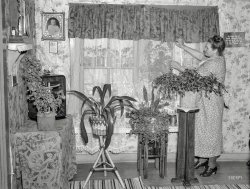
- Street View: 1937
- New Orleans circa 1937. "837 Gov. Nicholls Street." We just dropped by to say hi. 8x10 inch ...
So very Blanche DuBois My mother was born in 1937 in Mississippi but reared in Baton Rouge. She lived in the bottom half of ... Posted by Dave - 07/22/2012 - 4:42pm -
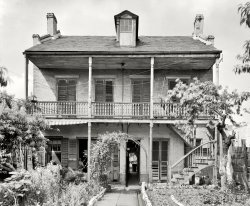
- The Candy Man: 1937
- August 1937. "Street in Manchester, New Hampshire." The Merchants of Manchester. ... Edwin Locke. View full size.
Lake Ave From the 1937 city directory, there was a Red Arrow Lunch at 37 Lake, a barber at 41 ... Posted by Dave - 04/11/2013 - 8:55am -
![The Candy Man: 1937 August 1937. "Street in Manchester, New Hampshire." The Merchants of Manchester. Medium-format nitrate negative by Edwin Locke. View full size.
Lake AveFrom the 1937 city directory, there was a Red Arrow Lunch at 37 Lake, a barber at 41 Lake, and a confectioner at 47 Lake. The block has been 'modernized'. There is still a Red Arrow Diner in town at one of the 1930 addresses where there was a Red Arrow Lunch. I'd like to know more about the 'Red Arrow Lunch System'; seems they had several places.
Gum DispenserI'm pretty sure that is a gum dispensing machine in front of the Red Arrow. Can anyone make out the name?
[Looks like one of these. - tterrace]
Awesome. You guys rock.
Red ArrowThe Red Arrow diner is a Manchester landmark,known for it's tourtiere.Open 24 hours a day, it's seen many politicians swing through to meet voters.
1931 PontiacA 1931 Pontiac poking its nose in - the radiator cap looks to be Pontiac, otherwise it could easily be the Pontiac's "companion," a 1931 Oakland, which would have been the last model year before GM retired the brand.
White ShoesNice. Clark Griswold would be jealous. Hell I'm jealous!
What Is That?Can anyone shed light on what that S-shaped coil is in the window of the storefront on the left side of the picture?
I got one for youHow many Candy store owners does it take to change a light bulb?
All gone todayAssuming we're looking at the beginning, even-numbered side of Lake Avenue, nothing in this picture remains today. The Verizon Wireless Arena, built about ten years ago, occupies the site.
What's in a name?I do believe the title of this photograph would have a whole different
meaning to folks like Robert Johnson, Blind Lemon Jefferson and Elvis.
CopenhagenI didn't know Copenhagen brand snuff went back that far. The advertisement looked all too familiar since this was my father's brand of snuff for most of his life. I grew up seeing a lot of Copenhagen.
What that isare pipes for refrigerant to cool window showcase, probably for meats.
Red Arrow LaunchHow many potential customers never found the place, following the arrow's direction?
(The Gallery, Edwin Locke, Small Towns, Stores & Markets)](https://www.shorpy.com/files/images/SHORPY_8b30927u.thumbnail.jpg)
- Chalmers Castle: 1937
- 1937. Charleston, South Carolina. "Old Armory, 8 Chalmers Street. Original ... seat to safety, given the massive crack already in it by 1937. Or it decrenallated itself.
I confess I had to look it up. That's ... to the year 1872?
But, as the picture is taken in 1937, I suppose they all have something to do with the African American ... Posted by Dave - 03/26/2014 - 7:09pm -
![Chalmers Castle: 1937 1937. Charleston, South Carolina. "Old Armory, 8 Chalmers Street. Original structure dates to 1851. Deutschen Feuer Kompagnie until merged with city fire department, then Engine House No. 1 by 1881; Carolina Light Infantry armory until 1907; then Good Samaritan Hall and Embry Mission. Abuts Old Slave Market." 8x10 acetate negative by Frances Benjamin Johnston. View full size.
Of course it's still thereThey don't tend to demolish old buildings in Charleston.
[Maybe they don't demolish, but they do decrenellate. -Dave]
Decrenellate indeedI suspect the architecture took a back seat to safety, given the massive crack already in it by 1937. Or it decrenallated itself.
I confessI had to look it up. That's why I haunt Shorpy--to learn stuff.
Gas fixtureIs that what the metal hooked pipe over the front door is?
What is it used for today?
Slave marketThe bldg. to the immediate right of Charmers Castle seems to read "Old Slave Market". Am I reading that correctly?
[Now try the caption. -tterrace]
Slave marketYes that's an Old Slave Market. It's now a museum. Technically it was an auction house that sold anything that came off a ship including slaves. It was renamed "Old Slave Market" by the time this picture was taken.
1872"Chalmers Castle," as Dave strikingly calls this building, has been designed by Architect Edward C. Jones, read more about the Charleston Historic and Former Firehouses.
As the structure dates to 1851, I wonder why 1872 is the date that is to be seen on the building. I cannot relate the year to the years mentioned in the caption (by Frances Benjamin Johnston, I suppose) either.
Apart from that, I tried to find out what sign and text are written on the gable, they are perhaps related to the year 1872?
But, as the picture is taken in 1937, I suppose they all have something to do with the African American charitable organizations "Good Samaritan Hall" or the "Embry Mission," who were the most recent users of the building until then.
(The Gallery, Charleston, F.B. Johnston)](https://www.shorpy.com/files/images/SHORPY_03394a.thumbnail.jpg)
- Uneeda Baby: 1937
- New Orleans circa 1937. "Dumaine Street at Bourbon." Momma's balcony scene. 8x10 inch safety ... Posted by Dave - 08/14/2012 - 3:55pm -
![Uneeda Baby: 1937 New Orleans circa 1937. "Dumaine Street at Bourbon." Momma's balcony scene. 8x10 inch safety negative by Frances Benjamin Johnston. View full size.
A closer lookThe house on Dumaine in the 21st century.
Step Right UpThe steps in front of the doors look as though they were designed to be picked up and carried. In the new photo posted here they look to have been replaced with brick and cement. Any Shorpsters in NO know about the steps?
Now the Biscuit Palace Guest Househttp://www.biscuitpalace.com/
Happily, the old Uneeda Biscuit sign remains.
Building There, Baby Gone.View Larger Map
The oval thingsTerra-cotta foundation ventilators. Lots of em in New Orleans.
Stoops, Not StepsI am a Shorpster from New Orleans, and the wooden stoops are attached to the buildings. Some have been replaced with cement analogs over the years, but are still called stoops. I have stood where that lady is standing, a friend of mine owns that guest house.
StoopsInteresting that the popular New York-ism "stoop" should be used in New Orleans. The word originally comes from the Dutch "stoep," meaning small front porch or steps.
Oval VentsThose grilles are usually cast iron.
Before and after KatrinaThis is an area I have spent a lot of time in over the years and the Uneeda sign is one of the best examples of old painted advertising in the French Quarter.
Unfortunately as with many things in New Orleans, Katrina wasn't kind to it, but it is still there.
I am posting one picture I took in 2003 and another I took in 2006. You can see there was damage to the building and unfortunately, some really crappy reconstruction of the damage.
Stoops on the BanquetteA lot of the stoops throughout the city are still in use today and many more are wooden. Some people replace them with brick or cement for aesthetic preferences. The sidewalks are referred to as banquettes in New Orleans. The character Santa Battaglia mentions in "A Confederacy of Dunces" of how in the summer in her childhood the family would often spend all evening on the banquette until midnight when the house finally cooled down enough for them to sleep. In many areas of the city, family and friends still spend evening chatting, drinking, and resting on their stoops or in kitchen chairs on the banquette. The oval vents are still prolific throughout the city and help release hot air trapped under the houses but are horrible when the winter wind blows through. The roof over-hangs that jut out over the sidewalks are referred to as "abat-vents" (a-bah-vonts) creole french for "windbreakers" They helped direct the breeze into the house and kept rain out.
Three days ago!I shot this just this week.
Biscuit PalaceMy wife and I rented the room that leads to the balcony that that woman is standing on.
http://www.biscuit-palace.com/
This Property Is CondemnedI was watching the movie "This Property Is Condemned" with Natalie Wood and Robert Redford, and caught sight of this building. I was kind of excited to recognize a landmark that you all had presented in the site.
[You have a sharp eye (and memory). - Dave]
(The Gallery, F.B. Johnston, Kids, New Orleans)](https://www.shorpy.com/files/images/01259u.thumbnail.jpg)
- Generation Gap: 1937
- New Orleans circa 1937. "Courtyard at 1133-1135 Chartres Street." Young and old, hangin' with the ... Posted by Dave - 08/03/2012 - 4:08pm -
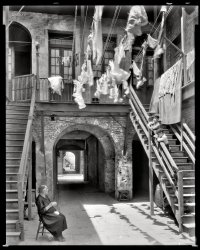
- Jump-Start: 1937
- Washington, D.C., circa 1937. "Children's Hospital Rotary." The young man hooked up to a Cambridge ... Posted by Dave - 08/19/2015 - 9:33am -
![Jump-Start: 1937 Washington, D.C., circa 1937. "Children's Hospital Rotary." The young man hooked up to a Cambridge Instrument Model X900 Thingamambob. Medical technology experts please weigh in. Harris & Ewing glassneg. View full size.
Cambridge ElectrocardiographMore here.
Obviously This is Nurse Frankenstein carrying on the family business.
Last CookieIt's a lie detector.
ElectrocardiographyCambridge Scientific was an early developer of the EKG machine. Prior to 1920, patients had to sit, with one hand and their feet, in buckets of salt water. Later, the contact electrode was invented and the buckets of water were used to mop the floors. There are just three leads connected to the patient in the photo. None seem to go to the chest area as do modern EKGs. Still, my money is on EKG machine.
Universal Nightmare GeneratorThe murals on the wall were clearly created by someone under that machine's influence.
Early EKGThe boy is having an electrocardiogram. He probably had a run-in with rheumatic fever and has developed heart trouble as a result.
Don't think it's an electrocardiograph.Yes the machine is similar to the Cambridge electrograph pictured in the submission by vintagetvs, but there are no electrode leads attached to the chest area which would be absolutely required for an EKG, nor does it appear there are enough unused leads for that purpose. The two visible leads are at the wrist and ankle, typical spots to detect the radial and tibial pulse, which causes me to guess that this instrument is designed to detect, monitor, record and/or amplify pulse rate and strength, which is often difficult to detect in children.
[These were the standard electrode positions until precordial leads were established as standard in 1938. -tterrace]
I stand corrected. Gary Hoff's explanation leaves no doubt as to what the instrument is. Many thanks!
This won't hurt a bitThis Shorpy post from 2009 looks like the same setup.
Whatever it isit puts out enough voltage to knock your sock off.
A vintage ECG machineTo this retired cardiologist and medical history buff, this is easily recognizable as an early ECG machine. The equipment is based on a string galvanometer that vibrates sort of in tune to the heart's electrical activity. The string in this apparatus was photographed through a light and its vibrations recorded as the familiar waves on a photographic plate. These were in turn recorded, cut out and pasted on a piece of cardboard. Before the 1930s there were only 3 leads (to the limbs, as here) that were used. After that another three, called augmented leads, were devised, recorded with the same wiring. Then later on came the chest leads that some posters here commented on. And yes, I'd guess this boy might have had a brush with rheumatic fever.
Early modelEarly version of the machine that goes "ping."
Its an ECGLong time viewer, first time poster. The device is an ECG that utilized Willem Einthoven's principle of detecting electrical currents produced by the heart. His early system only used three electrodes. Wikipedia has an entry that includes a nice picture that closely resembles the device in your picture.
https://en.wikipedia.org/wiki/Willem_Einthoven
Creepy muralsPretty sure those creepy murals aren't sweetening the deal for that young fellow.
MaintenanceMy field is equipment maintenance. The first thing I noticed was the tattered looking cord on the floor. It looks like it's been run over many times. I would be changing that out asap as a safety hazard.
Early attemptThe stories painted on the walls are an early attempt to make the hospital more welcoming to its young charges. Modern children's hospitals do this much better, with playgrounds, giant murals, and other touches that make them less terrifying for patients and parents. Not using the Cambridge Electrocardiograph also helps with that.
(Technology, The Gallery, D.C., Harris + Ewing, Kids, Medicine)](https://www.shorpy.com/files/images/SHORPY-23571a.thumbnail.jpg)
- Dishpan Hans: 1937
- September 1937. Effie, Minnesota. "Washing dishes in lumber camp." Medium format negative ... are only about 90 people in Effie. Must have been more in 1937, when there were still trees to cut.
[This was a lumber camp near ... Posted by Dave - 02/26/2010 - 7:04pm -
![Dishpan Hans: 1937 September 1937. Effie, Minnesota. "Washing dishes in lumber camp." Medium format negative by Russell Lee, Farm Security Administration. View full size.
Behind in his workAt least when the young man tired of scrubbing, he could look up and see the nice view! *wink*, *wink*
InspirationTacked up on the window frame just above his head is a rather bawdy picture of a young lady.
Maybe she is his only company in the kitchen, besides all those huge coffee pots hanging up. Seeing all those big coffee pots makes me want a good cup of coffee too.
199, 198, 197 ...It looks like he had to do a lot of washing by the amount of dishes in the picture.
Definition of RusticWow! Now that's a no-frills setup. I'd give my last molar to get a glimpse in the "sink." What do you want to bet he's got a couple of wash tubs in there? Nary a speck of porcelain in sight.
[Except on all those dishes. - Dave]
Who made this mess?There are only about 90 people in Effie. Must have been more in 1937, when there were still trees to cut.
[This was a lumber camp near the town. The lumberjack population being somewhat transient. - Dave]
Gotta sayThat he's a fellow with a lot of Pride in his work.
Obvious StatementUnless Dave is reviewing a similar comment not yet posted, let me be the first to note that:
This young man has a lot of Pride (tm) in his work.
[You may groan now]
All I can make out on the boxes is Pride Washing Powder. Performing a quick search online I found nothing - but Dave found the following images:
I'll show my son this!My 16 YO son works at a restaurant where he usually has to wash dishes. He does it using modern equipment, of course, but is still much happier when they let him do something else. I think maybe this picture might help him feel like he doesn't have it so bad, though! I wonder how many hours this poor young man had spent standing in front of that sink, and how many he still had to go!
More than just "pride"I think he probably had a lot of "Pride and Joy" in his work.
(The Gallery, Mining, Russell Lee)](https://www.shorpy.com/files/images/8b19964u.thumbnail.jpg)
- On the House: 1937
- August 1937. "A drink on the house. Lumberjacks, proprietor and lady attendant in ... Posted by Dave - 12/29/2012 - 9:05am -
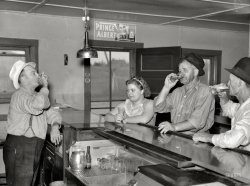
- The Good Earth: 1937
- June 1937. "Wife of Texas tenant farmer. The wide lands of the Texas Panhandle are ... Posted by Dave - 07/30/2012 - 2:45pm -
![The Good Earth: 1937 June 1937. "Wife of Texas tenant farmer. The wide lands of the Texas Panhandle are typically operated by white tenant farmers, i.e., those who possess teams and tools and some managerial capacity." Medium-format nitrate negative by Dorothea Lange for the Farm Security Administration. View full size.
Field FashionI believe a scythe would be the more appropriate accessory for this
outfit. I guess I'll have to wait for October.
No RelationIs there a Mrs. Grim Reaper?
Plains JaneThis is a remarkable image. A solitary figure (Dad and team notwithstanding) in a forbidding landscape, with an agricultural implement only slightly more sophisticated than a stick. It helps illumine the enormity of the task which literally thousands of our forebears faced and leaves one wondering, "How did they do it?"
Up at dawnLooks like she has a long day ahead of her.
Bonnet and HoeReminds me of my grandparents. Gramma would make up a dozen or more bonnets each winter for her and my aunts to wear while working outside. She used flour sacks for the fabric. Notice the hoe handle is extra long. Grandpa would always whittle out hoe handles that would be at least 6 feet long. Much easier on the back. Fond memories now, but hard sweaty work back in the '60s.
Now I knowWhat they mean by the phrase "dirt farmer"
SodbusterI see what looks like a mule team near the horizon. I guess the woman is finishing the job that they started. Sometimes when I see a mule I wonder how the first guy decided to try mating a horse with a donkey to get that result. Or was it just an accidental discovery. Since mules cannot reproduce, horses and donkeys had to get together a lot in the old days.
Help pleaseThere is a famous painting that is very similar to this, I had a poster of it in my room as a child. Can anyone help me with the name of that painting or artist?
Spas, gyms and tanning parlorsThis hard-working industrious woman would need a very convincing argument to pay a membership fee to any of those establishments.
re: Help PleaseIs this it?
Woman with a Rake
Jean-François Millet c. 1856-7
The bee's kneesThank you so much Dave. I can not tell you how important that painting was for me. Now I know where to find a print. Again Thank you!
[Thank tterrace! - Dave]
(The Gallery, Agriculture, Dorothea Lange)](https://www.shorpy.com/files/images/8b31982u.thumbnail.jpg)
- Glass Paints Oils: 1937
- Circa 1937. "Hardware store, 906 Bourbon Street, New Orleans." Carrying a full line ... Posted by Dave - 09/02/2013 - 1:36pm -
![Glass Paints Oils: 1937 Circa 1937. "Hardware store, 906 Bourbon Street, New Orleans." Carrying a full line of protectants and preservatives, none of which seem to be suitable for the store itself. 8x10 acetate negative by Frances Benjamin Johnston. View full size.
Those bucketsI see little sliding doors on the sides, which would appear to cover those holes when slid down all the way. I guess it's easier to slide open a door on a heavy bucket than to tip it over and pour. Seems like there'd be a bit of leakage in these models, though.
[I suspect the holes are for ventilation and that the lining is fireproof. - Dave]
NOLA native says906 is the not the restaurant with the neon (now) but the business next door (to the right) with the red chairs, which is currently listed as a hair salon.
On the corner (going towards Canal St) are the iconic Clover Grill and across the street Cafe Lafitte in Exile which is a really famous gay bar as it claims status at the oldest continuously operating gay bar in North America.
Could be the placeView Larger Map
Back when the Quarter was a neighborhoodRather than a tourist attraction. Real stuff for real people doing real things like painting the bathroom cupboard or replacing a broken windowpane. My former home town of Carmel, CA, went from three hardware stores, five groceries, seven filling stations, and three drug stores in the '50s to zero, one, one, and one, respectively, by the '80s, but boy did we gain some galleries and boutiques!
Three bucketsI thought at first they hold items for sale, but they could have been used to strain the paint that was sold.
Holey bucketsI'm curious: what would the three buckets with holes in them hung on the door frame be used for?
Saulny's storeIn the 1880 census he is one year old, the son of 2 "mulattos", but listed as black in later census years. He's the son of a shoemaker, Louis Saulny, born 1846. Louis's father is also listed as a "mulatto", a carpenter born 1827. He died when he was 31.
Pierre SAULNY was the first Saulny in USA. He was born in Nantes, France. There is a date of birth in 1774. Some data doesn’t match so we take between 1894 to 1800 as his date of birth. He married Catherine DINET (1797-1853) free woman of color native of Pestel on the Island of Santo Domingo, Haiti. They married in New Orleans in 1820 and lived in the Suburb Marigny on Moreau Street between Elysian Fields and Frenchmen Streets since 1822 in a house situated on Esplanade Street between Conde and Royal Streets, until at least 1835. The residence of Catherine Dinet is an area that exists today and was inhabited by many free people of color as well as Creoles of European descent.
Another BarYep, that's exactly where it was, just behind Clover Grill.
I think Kozel is rightComparing the position of the window (closer to the door on the right), and the shape of the jamb, sills and lintels, I'm pretty sure the building with the neon is correct. The original photo shows a full length porch on top which is now separate balconies, but the side of the building still has porches which may indicate the front had the same ones.
Or, it could just be 907 across the street, which still has the upper porch in the right place.
[Below, 907-909 Bourbon Street. - Dave]
John McCrady School of Fine ArtsI went to art school in that white building that kozel posted. I believe I remember Mrs. McCrady saying that it was a hardware store before it was the school. But that was over 30 years ago and memories fade and Mrs Mac died long ago.
Three BucketsMy father would take me duck hunting in the 50's and we used one in our duck blind to stay warm.The small door would let more air into the fire. Worked really good when you were freezing.
(The Gallery, F.B. Johnston, New Orleans, Stores & Markets)](https://www.shorpy.com/files/images/SHORPY_01208a.thumbnail.jpg)
- The Quarters: 1937
- 1937. Charleston, South Carolina. 7-9-11 Beaufain Street, "The Quarters." 8x10 ... filled with cinder blocks? I was surprised to see that in 1937 New Orleans had drains for rainwater. I suppose there is a correct word ... Posted by Dave - 07/22/2012 - 4:40pm -
![The Quarters: 1937 1937. Charleston, South Carolina. 7-9-11 Beaufain Street, "The Quarters." 8x10 inch acetate negative by Frances Benjamin Johnston. View full size.
MusingsWhat would have been in the square that is between the steps, that appears to be filled with cinder blocks? I was surprised to see that in 1937 New Orleans had drains for rainwater. I suppose there is a correct word for that, but I can't think of it. And what is on the notice that is tacked to the left pillar? Looks like there have been others.
["Storm drains," and "For Rent." - Dave]
CarefulWatch that first step, it's a lulu.
VestigesThe wreckage of another fine old house. Look at the molding over the door.
Feelgood Pic of the DayI love these -- they make me feel so much better about my own deferred D-I-Y projects.
Back on BeaufainThis was the former rectory of St. Michael's Church. Below, a view of the house taken May 25, 1940, by C.O. Greene for the Historic American Buildings Survey. Additional information: "To be renovated 1941." And, from 1975: "Built before Revolution; demolished after 1944." Whereas FBJ gives the address as Nos. 7 through 11 Beaufain, HABS says 56 Beaufain. Click to enlarge.
Clean cut kidsInteresting that the kids seem to be dressed so neatly, in contrast to some of the poor kids in other photos.
White shirts and pants weren't part of the costume for the Boston newsies for example.
https://www.shorpy.com/node/15
FBJI love Frances Benjamin Johnston's work. I need all of her we can get on Shorpy.
[Only around 7,999 left to go. Pull up a chair and make yourself comfortable. - Dave]
(The Gallery, Charleston, F.B. Johnston, Kids)](https://www.shorpy.com/files/images/03356u.thumbnail.jpg)
- Smallville: 1937
- August 1937. "Houses in Winton, Minnesota -- lumber bust town." A two-house town, on a ... now match up in both the modern street view and the 1937 photo.
I apologize for my previous error.
JellyBelly
PS: ... What an eye! This photo is so rich in capturing the 1937 moment in far northern Minnesota.
(The Gallery, Dogs, Railroads, ... Posted by Dave - 12/13/2012 - 11:50am -
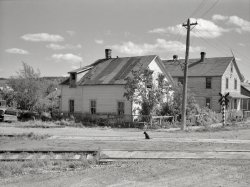
- Fix-a-Flat: 1937
- March 1937. "Migratory agricultural worker family making tire repairs along ... Posted by Dave - 01/27/2015 - 8:49pm -
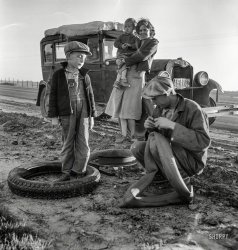
- Picture Window: 1937
- April 1937. "Girl at Gee's Bend. Descendants of slaves of the Pettway family are ... Posted by Dave - 07/30/2012 - 10:49am -
![Picture Window: 1937 April 1937. "Girl at Gee's Bend. Descendants of slaves of the Pettway family are still living very primitively on the plantation." Wilcox County, Alabama. Medium format nitrate negative by Arthur Rothstein for the FSA. View full size.
The ironing is delicious!Wow, how ironic is it that the "window" to the house is covered by an advertisement for Cellophane.
[Yes, delicious ironing. Must be the starch. - Dave]
Proud faceProud face the girl has, I like the picture!
Girl in the windowI am amazed almost every day by the quality - and qualities - of the photographs. This one reminds me so much of Andrew Wyeth.
Fine ShotThere are so many fabulous photos on Shorpy, but once in a while one really stands out. This is one.
Gee's BendJoseph Gee, a planter from Halifax, North Carolina established in 1816 a plantation, and named the place for himself: "Gee's Bend." Mark Pettway bought Gee's Bend from his relatives, Sterling and Charles Gee (nephews of Joseph), in 1845 to settle a $29,000 debt. A year later, Pettway and his family moved there in a caravan with a hundred or more slaves. Except for one cook, the slaves literally walked from North Carolina to Gee's Bend. The 10,000 acre plantation retained "Gee" for its name but the name of each of the slaves became "Pettway", a name that has prevailed in Wilcox County until the present day. Today, if someone from Gee's Bend is named Pettway, he or she is a descendant or married to a descendant of those Mark Pettway wagon-train slaves who walked from North Carolina. That is why many of the black tenants Arthur Rothstein photographed (as Annie Pettway Bendolph below) were named Pettway.
By the way, the Resettlement Administration reports of the 1930s already emphasized ... the unreliable ferry.
This, and more can be found here and here.
In the "Will of Mark H. Pettway, Wilcox County, Alabama - July 1860," you can read which of his properties he would "give and bequeath" [un]to his beloved Wife, his eight daughters (depending on their civil status: married, unmarried), his son and his grand children. Among his daughters there was one who seems was married, but practically divorced, because her legacy is given in trust to his brother in law and son in law "to have and hold the same in trust for the sole use & benefit of my said daughter and her children free from the control and management of her husband." Among the properties were: fifty head of sheep, ... negroes and their increase (by name, among which: Peter No 14, Ginny & carpenter tools, Altimare -the ugly- Bett, Bathemia Dempseys and his black Smith tools), ... the gold watch usually worn by myself ... and a gold watch known as the watch with the gold face.
(The Gallery, Arthur Rothstein, Gee's Bend)](https://www.shorpy.com/files/images/8b35942u.thumbnail.jpg)
- Fancy Drainpipe: 1937
- Savannah, Georgia, circa 1937. "Davenport house, Columbus Square." 8x10 inch acetate negative by Frances ... Posted by Dave - 08/30/2012 - 11:05am -
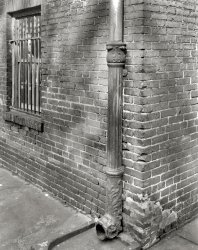
- Termite Motel: 1937
- August 1937. "Old house in Tower, Minnesota, former prosperous lumber town." Medium ... Posted by Dave - 09/05/2012 - 7:08pm -
![Termite Motel: 1937 August 1937. "Old house in Tower, Minnesota, former prosperous lumber town." Medium format nitrate negative by Russell Lee for the FSA. View full size.
Handyman SpecialThis fixer-upper only needs a for-sale sign out front!
Coming Mother!You couldn't build a creepier looking place on a movie set! Looks like Norman Bates's summer cottage!
An Iron TownI know a bit about this town not much as being lumberous but it is the oldest town in the Iron Range. The Iron Range is an area with very much iron ore.
Termite TerraceYou missed the obvious play on words.
[That was actually the original title, but I didn't want to confuse people. - Dave]
Mouse MotelI'm fairly sure termites aren't so much of a problem way up north, but mice and other rodents sure are.
A little questionSorry if this sounds too dumb to ask, but I've always wondered why those old-style houses were not built at ground level, but rather high.
[The floor of a frame house is elevated to keep it from rotting. And in a cold climate, the earth is a heat sink. The house will be much easier to keep warm if the floor isn't sitting on the ground or if it has a basement under it. - Dave]
Those meddling kids and their dog Scooby assisted the Globetrotters in ridding this place of spirits back in 1973.
Victorian GemWhen this house was new, maybe in the 1870s or '80s, and had a fresh coat of paint in probably three colors, it would have been a sparkling gem. And with a riot of color in the flower garden in front. When they got old and worn out, they were demolished by the millions, like so much trash. You can't build 'em like that any more!
Ah, home crap homeI think this was the inspiration for the film "The Money Pit."
Potential is in the eye of the beholderI see lots of easy potential with this place! Mow the lawn, re-shingle the roof, give it a fresh coat of paint and it would look hundreds of times better! Of course, a friend once joked with me that I would buy a house with no roof if I thought it had enough potential! (this was after I showed him pictures of a gutted 1948 Chevy I was considering buying as a daily driver)
WhoaOk, now I have a new template in my mind for "haunted house." This place looks terrifying during the day, I wonder what it would've looked like under the light of a full moon. Scary, that's what. At least I can rest assured that it's no longer standing. Or is it???
(The Gallery, Russell Lee)](https://www.shorpy.com/files/images/8b36684u.thumbnail.jpg)
- Toulouse Street: 1937
- New Orleans circa 1937. "813-815 Toulouse Street." Watch out for the neighbors. 8x10 inch acetate ... Posted by Dave - 08/14/2012 - 3:39pm -
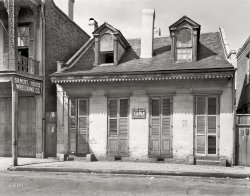
- Rex Theatre: 1937
- Leland, Mississippi. June 1937. View full size. Photograph by Dorothea Lange.
Tarzan It's ... movies on the playbills would mark the year as 1935, not 1937.
[That's because the movies are two years old. Not exactly a ... Posted by Dave - 07/30/2012 - 2:40pm -
![Rex Theatre: 1937 Leland, Mississippi. June 1937. View full size. Photograph by Dorothea Lange.
TarzanIt's interesting that the main feature is a Tarzan movie - these were pretty racist, showing the "superior" white man among the "primitive" natives. This story is set in Guatemala, not Africa, so Lord Greystoke gets to show his stuff on a different continent.
TarzanI wonder what color they were?
Powerful photo indeed.Powerful photo indeed.
Wrong Year?The movies on the playbills would mark the year as 1935, not 1937.
[That's because the movies are two years old. Not exactly a first-run house. - Dave]
The mouths of babes.. My grand-daughter saw one of these photos and asked me, 'Gran-pa, did people used to come in different colors?', I didn't know whether to laugh or cry.
(The Gallery, Dorothea Lange, Great Depression, Movies)](https://www.shorpy.com/files/images/8b32104u.thumbnail.jpg)
- Desert Guns: 1937
- June 1937. "Oklahoma City. Idle men attend the morning movies. There are three such ... Posted by Dave - 05/04/2018 - 11:30am -
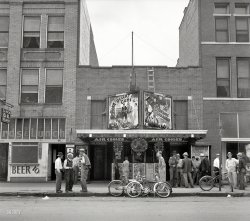
- Americus: 1937
- July 1937. "Thirteen-year old sharecropper boy near Americus, Georgia." ... Posted by Dave - 07/25/2012 - 6:52pm -
![Americus: 1937 July 1937. "Thirteen-year old sharecropper boy near Americus, Georgia." Medium-format nitrate negative by Dorothea Lange. View full size.
Brings back memories.That boy looks like my brother Bill.
PlowboyHis clothes are falling off, but he looks so proud. Great picture.
A powerful photoSeventeen in 1941, I wonder if this boy would or could have enlisted. It looks like he's been working that plow for quite some years, and would be ready to move on, given any sort of chance; though he was possibly the family breadwinner.
There is nothing to sayJust look into that face.
My grandfather used a plow like this.He was so young, the handles would smack him in the head if he hit a rock. Think about that.
PovertyDave, this comment isn't really meant to be posted, but I want to thank you for not posting every comment that's submitted. As I'm sure you've found by now, just a simple photograph of a young black sharecropper will bring all sorts of racist comments. And who needs that?
[No such comments for this photo. - Dave]
Thanks for the great blog. It's one of my favorites. By the way, I'm live in New Orleans, so I especially enjoy the pictures of old New Orleans.
Is it 100% realCertain aspects of the clothes, appearance of the subject, the pose, all these items together just make me feel this is a fabricated picture. They did do those things even back then.
[Click here, take a look at the 5,000 or so photos in this series and judge for yourself. - Dave]
Hard workMy grandfather used to tell tales of walking all day behind one of these bottom plows, all day, one row at the time. There are still very many of these one-row plows stored away and forgotten sitting under barns all over Georgia to this day.
Today we have air conditioned cabs and 10+ row plows that can do in less than an hour what it would probably take this boy the better part of a week to do.
From what I can make out it looks like cotton he's plowing.
(The Gallery, Agriculture, Dorothea Lange)](https://www.shorpy.com/files/images/8b32269u.thumbnail.jpg)
- Detective Shanley: 1937
- ... and the Sun Newspaper Photograph Collection, 1937. View full size.
the notorious Chinatown Charlie She had 1000 ... Posted by Ken - 09/08/2011 - 1:18pm -
![Detective Shanley: 1937 New York City detective Mary Agnes Shanley pulls a pistol out of her handbag. Shanley shows what awaits a pickpocket. She had more than a thousand career arrests. From the New York World-Telegram and the Sun Newspaper Photograph Collection, 1937. View full size.
the notorious Chinatown CharlieShe had 1000 career arrests including "Chinatown Charlie"
I dont know who he is but he sounds like a tough guy, good work Mary
If I'd meet someone likeIf I'd meet someone like that today, I'd have two things to say:
"Get yer finger out of that trigger guard"
&
"Don't carry in a purse that can be forgotten or snatched".
Ok, *three* things to say.
"you rock, shooterchickie"
Cagney and LaceyReminds me of Cagney!
Reminds me...of the old song "Pistol packing mama" (lay that pistol down). It was a big hit back when...
Southpaw?is she really a lefty or is the negative flipped?
[Not flipped. - Dave]
Even better!that makes her even more special!
Flipped?Are you sure about that, Dave? Women's clothes button right-over-left, and men's clothes button left-over-right. Her dress buttons left-over-right... either it was homemade and someone made a mistake, or the image has been flipped.
[This image is identical in orientation to the 60-year-old print it was scanned from, which has writing in the upper right corner. The negative may have been flipped (or, in newsphoto parlance, "flopped") before the print was made to have the subject facing in the desired direction for the layout of the newspaper page this picture appeared on. - Dave]
Mme. ShanleyNot exactly my idea of glamour.
And quite deliberately soOften criminals seek out female victims who they believe to be less attractive. They assume that bystanders will be less likely to respond to calls for help from a less attractive woman. In the case of a sexual attack, they often suspect that an unattractive woman will be written off as hysterical, stupid, or lying.
Flipped?I tried zooming in on the revolver. IF I am seeing what I think I am seeing (the cylinder release latch), then I would say the the picture wasn't "flopped" since most US revolvers have the cylinder latch on the left side of the frame.
Love the site. Great work.
Mary ShanleyFound this picture of a newspaper page with this photo
http://popartmachine.com/item/pop_art/LOC+1166351
that shows the picture flipped the other way (right-handed)... but the site also shows the Shorpy "lefty" picture.
Pistol Packin MamaThis picture is perfectly indicative of why I love Shorpy so much.
(The Gallery, Portraits)](https://www.shorpy.com/files/images/3c34714u.thumbnail.jpg)
- Gee's Bend: 1937
- February 1937. Gee's Bend, Alabama. Descendants of former slaves of the Pettway ... perceptions.
The Pettway Plantation was purchased in 1937 by the FSA and a full project was developed there including schools, ... Posted by Dave - 07/30/2012 - 10:49am -
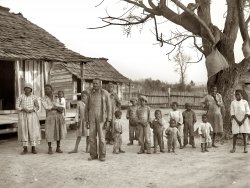
- Clean Living: 1937
- Washington, D.C. June 4, 1937. "Trailer camp." And what looks like the trailer seen earlier here . ... Posted by Dave - 08/27/2012 - 7:10pm -
![Clean Living: 1937 Washington, D.C. June 4, 1937. "Trailer camp." And what looks like the trailer seen earlier here. Harris & Ewing Collection glass negative. View full size.
Griffin Allwhite Shoe Polishis what I used to use to clean my white bucks when they were the shoe of the day. I don't think they have that any more. And if this is a trailer park, where are the flamingos?
Camping shoesLook at the moderately high heels they are wearing in a camping trailer park. Plus dresses on an outing. You don't see that level of dress in camping parks of today.
What is the table in the infield used for?
House cleaning.The only trailer trash I see is the empty matchbook on the ground.
White Lead PasteWhat's the Eagle All Purpose White Lead Paste, on the box serving as a doorstep?
[White lead paste was a filler that could be thinned with linseed oil and used as a caulk or putty. Mixed with pigments, it could be used as paint. - Dave]
A Trailer Camp"Trailer camps" used to be quite common. The trailers (and you can see several in the background) had beds and a small living area, cooking was usually done outdoors or under a shelter, and there was a central shower/toilet/laundry facility. This is doubtless the white building in the background.
Check out these vintage postcards for a more complete glimpse into this prewar Vagabond lifestyle!
I love stuff like this!
State FairThis reminds me of the 1945 musical in which the family takes their little trailer to the fair for a week.
Momdoesn't look like a happy camper.
Random observationsNever go camping without your rubber floor mat.
How about the portal height of that trailer? Mom is standing on the ground, yet wiping near the top of the door.
It started way back then: make windows that stick out, so when you walk by they poke you in the eye. (Don't ask how I know about that one.)
That TableCould it be a fixed grill for those who don't have a camping stove of some sort?
Clean and SpiffyI always wear my hairnet when camping as well. I find that it lends to the overall atmosphere.
Departure from the 1930s ordinaryAfter seeing so many photos of Depression-era people on the road, with whole families living out of their cars and trying to get work where it could be found, it's kind of refreshing to see people living on the road because they wanted to. Of course, I'm sure they were in the minority.
I guess that white lead paste was as necessary to 1930s RV owners as a tube of silicone would be today, for sealing those rivets and seams that always seem to leak.
(The Gallery, Cars, Trucks, Buses, D.C., Harris + Ewing, Travel & Vacation)](https://www.shorpy.com/files/images/22818a.thumbnail.jpg)
- Fresh Up: 1937
- September 1937. "Icehouse. Rosslyn, Virginia." Just across the Potomac from Washington, ... Posted by Dave - 03/13/2013 - 10:08am -
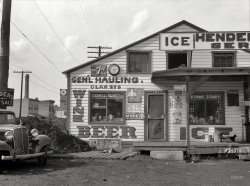
- Good Coffee: 1937
- May 1937. "Post office. Finlay, Texas." Magazine, caffeine, nicotine -- all your ... Posted by Dave - 06/18/2018 - 1:29pm -
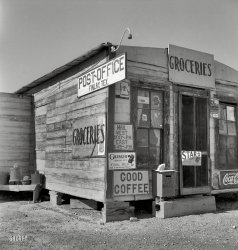
- Tired Treads: 1937
- October 1937. "Used tires -- Minot, North Dakota." Medium format acetate negative by ... Posted by Dave - 12/14/2018 - 1:52pm -
![Tired Treads: 1937 October 1937. "Used tires -- Minot, North Dakota." Medium format acetate negative by Russell Lee for the Farm Security Administration. View full size.
SomehowThis whole thing just begs for a Laurel & Hardy response. What potential for a really funny short!
Re: Ring tossOf course Dave is right. But please note, 1pictureisworth1000words: the stack on the right is on a shorter log than the one on the left, and it is NOT the log directly behind this short one, with wires attached. Look closely: there are three separate logs here. (Four, if you include the really tall one on the far right which is painted white where there are no climbing pegs.)
[Executive summary: The stack on the right is in front of a utility pole. - Dave]
Good ReceptionMost antennas ever.
Ralphie as an adult"My old man's spare tires were only actually tires in the academic sense. They were round and had once been made of rubber."
HOW ON EARTH?Just wondering how on earth they got those old tires stacked on such tall poles--especially the one that has utility wires running to and from it. My guess is that they must cut the tires to open them for placing on the stacks. Any other guesses?
[Ring toss! - Dave]
North Dakota?These were probably used to measure snow depth.
VulcanizingGet your ears pointed for free with purchase of four tires.
Hi ho the glamorous life Russell Lee must have been a real trouper. He went all the way to Minot, just to capture the majesty of these used tires. I can almost smell the filthy things.
Déjà vuNow it all makes sense.
Motto of Minot"Why not Minot?"
The answer: forty degrees below zero.
Backup motto of Minot:
"Forty below keeps the riff-raff out."
LocatedOpposite the Court House.
Mosquitoville!The clouds of bloodsuckers must have been impressive.
Pole on the rightIs used when they have to move the stack from one pole to the other while retaining the top-to-bottom order.
(Towers of Hanoi -- undergrad recursive programming exercise)
Culicidae TowersI can only imagine the number of mosquitoes growing inside those tires during warm, wet periods.
(The Gallery, Cars, Trucks, Buses, Gas Stations, Russell Lee)](https://www.shorpy.com/files/images/SHORPY-8b20081a.thumbnail.jpg)
- Shawnee Tavern: 1937
- April 1937. "The Posey Building of Shawneetown, Illinois, in which Abraham Lincoln ... Shawneetown was heavily damaged by the Ohio River Flood of 1937, and the townsite was moved three miles inland and the town rebuilt. From ... Posted by Dave - 10/28/2015 - 11:43am -
![Shawnee Tavern: 1937 April 1937. "The Posey Building of Shawneetown, Illinois, in which Abraham Lincoln and Robert Ingersoll had law offices." Now home to a newspaper and a bar. Photo by Russell Lee for the Resettlement Administration. View full size.
Deposeyed.These steps are all that remain of the Posey Building.
Wrong addressThe Posey building was in Gallatin
597 Main St
Gallatin, IL 62984
[Gallatin is not a town, but rather a county in Illinois; the county seat is Shawneetown. 62984 is the ZIP Code for Shawneetown. -tterrace]
Old ShawneetownAccording to Wikipedia, Shawneetown was heavily damaged by the Ohio River Flood of 1937, and the townsite was moved three miles inland and the town rebuilt. From the age of the buildings here, this must be what is now called Old Shawneetown (refer to the previous picture posted here for another building destroyed by the flood). The county seat is now in what is informally called New Shawneetown.
Gallatin DemocratThe newspaper is still being published:
Fred Murphy is the editor of the Gallatin Democrat.
Mailing address: PO Box 545, Shawneetown, IL 62984
There's no website for the paper though.
When was it torn down?Does anyone know when or why it was torn down? Seems like such a historic building should have been preserved. Or maybe the flood took its toll on it. Is that the high water mark I see?
Ghosts of Old ShawneetownWhen I lived in Southern Illinois in the 60s and 70s, most of the buildings along Main Street were still standing, although not in the best condition. I recall that most of them seemed to house a bar. Old Shawneetown was known as a hard-drinking very rough place. The denizens were commonly referred to as river rats. The decline began after the flood of 37 (which Russell Lee's photographs are documenting) and the Federal government paid to resettle the town on top of the bluff above the Ohio River, today known as New Shawneetown. Today there are only a couple of old downtown buildings still standing. One, the state bank building, shown recently in another Russell Lee shot, is an Illinois Historic site. The exterior is still in fairly good shape, or at least was when I last saw it about 4 or 5 years ago. The interior, unfortunately is crumbling lath and plaster and murals. You cannot go inside. The other major building still standing, on the levee side, is now a big regional biker bar called Hog Daddy's.
Same hydrantIt looks like the hydrant in the old photo and the one in the Google street view are one and the same.
(The Gallery, Cars, Trucks, Buses, Gas Stations, Russell Lee)](https://www.shorpy.com/files/images/SHORPY-8c51242u.thumbnail.jpg)
- Purr Me Another: 1937
- September 1937. "Lumberjack at the bar on Saturday night. Craigville, Minnesota." Photo ... Posted by Dave - 02/23/2018 - 5:24pm -
![Purr Me Another: 1937 September 1937. "Lumberjack at the bar on Saturday night. Craigville, Minnesota." Photo by Russell Lee for the Farm Security Administration. View full size.
Rough With The SmoothSo goes the story of a lumberjack who,
Brought his kitty into the bar bearing life's heavy load
Without a thought for himself, did with a sigh say,
"I'll have one for my baby, and one more for the road"
Ohhh I'm a lumberjack!And I'm OK.
I sleep all night and I work all day.
I cut down trees. I skip and jump.
I like to press wild flowers.
On Wednesday I pet kitties
That hang around in bars.
Long Branch saloon?Well, there's Miss Kitty.
This picture is incredibly sadI've sat here staring at it for ten minutes, trying to come up with a backstory that isn't totally depressing and tearjerking, and utterly failed.
[Spilled milk? - Dave]
Looks familiarI would not be surprised if that man is me in a past life.
Drinks, please!I'd like a "Catster", and for my little buddy, a "Hair of the Dog".
Deja vuBeen there, done that. (several times but without the cat).
SadThis picture almost makes me cry. And I'm 65 years old.
At leastHe has a job during the Great Depression, spotlessly clean hands, a full head of wavy hair and the friendship of a nice little cat. So there is hope for the lumberjack that he went on to enjoy better days.
HauntingLong time lurker here, but had to reg just to comment on this image; like others here this has haunted me. It is incredibly sad.
My photo class in college introduced me to the pics in The Family of Man - nothing in there was as profound as this.
Why hasn't this image captured all the available awards? Sarting with the Pulitzer & not stopping.
Although I have a professional printer which I use to print my art, I'm ordering a print as a Thank You for finding this image.
HauntingI enjoy coming to the site every couple weeks and reviewing old photos. Shorpy is a wonderful contribution to the internet.
Like previous commenters, this one stopped me in my tracks. What a intimate and revealing photograph, and what an incredible moment that was captured.
In a time when twitter posts about what is trending with a hashtag drive a newscycle, this photo, by comparison, arrests the mind of the viewer and depicts a shard of the man's soul.
Best, by fur!I nominate the title given to this photo as the "Most Clever" of the many Shorpy titles.
(The Gallery, Cats, Russell Lee)](https://www.shorpy.com/files/images/SHORPY-8b19906a1.thumbnail.jpg)























